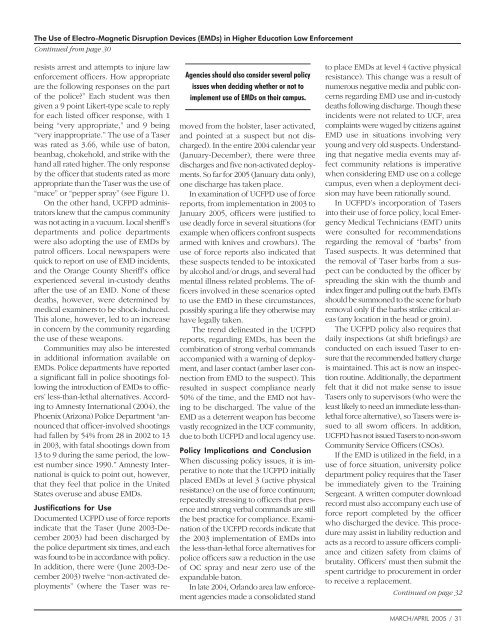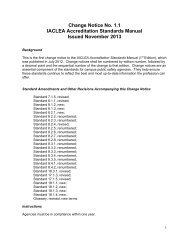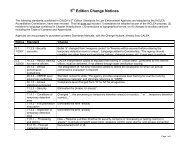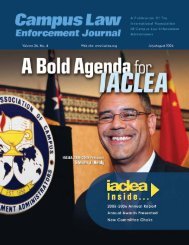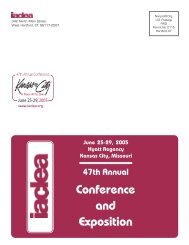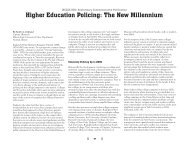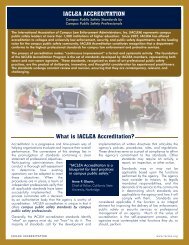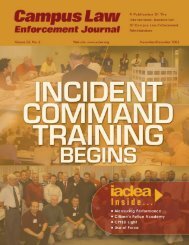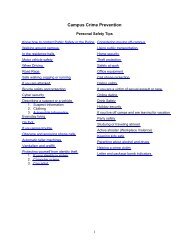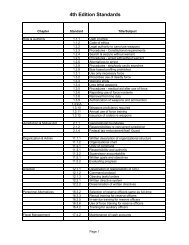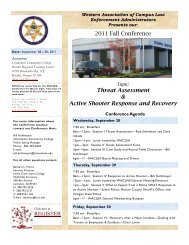Volume 35, No. 2 - March/April 2005 Campus Law ... - IACLEA
Volume 35, No. 2 - March/April 2005 Campus Law ... - IACLEA
Volume 35, No. 2 - March/April 2005 Campus Law ... - IACLEA
You also want an ePaper? Increase the reach of your titles
YUMPU automatically turns print PDFs into web optimized ePapers that Google loves.
The Use of Electro-Magnetic Disruption Devices (EMDs) in Higher Education <strong>Law</strong> Enforcement<br />
Continued from page 30<br />
resists arrest and attempts to injure law<br />
enforcement officers. How appropriate<br />
are the following responses on the part<br />
of the police?” Each student was then<br />
given a 9 point Likert-type scale to reply<br />
for each listed officer response, with 1<br />
being “very appropriate,” and 9 being<br />
“very inappropriate.” The use of a Taser<br />
was rated as 3.66, while use of baton,<br />
beanbag, chokehold, and strike with the<br />
hand all rated higher. The only response<br />
by the officer that students rated as more<br />
appropriate than the Taser was the use of<br />
“mace” or “pepper spray” (see Figure 1).<br />
On the other hand, UCFPD administrators<br />
knew that the campus community<br />
was not acting in a vacuum. Local sheriff’s<br />
departments and police departments<br />
were also adopting the use of EMDs by<br />
patrol officers. Local newspapers were<br />
quick to report on use of EMD incidents,<br />
and the Orange County Sheriff’s office<br />
experienced several in-custody deaths<br />
after the use of an EMD. <strong>No</strong>ne of these<br />
deaths, however, were determined by<br />
medical examiners to be shock-induced.<br />
This alone, however, led to an increase<br />
in concern by the community regarding<br />
the use of these weapons.<br />
Communities may also be interested<br />
in additional information available on<br />
EMDs. Police departments have reported<br />
a significant fall in police shootings following<br />
the introduction of EMDs to officers’<br />
less-than-lethal alternatives. According<br />
to Amnesty International (2004), the<br />
Phoenix (Arizona) Police Department “announced<br />
that officer-involved shootings<br />
had fallen by 54% from 28 in 2002 to 13<br />
in 2003, with fatal shootings down from<br />
13 to 9 during the same period, the lowest<br />
number since 1990.” Amnesty International<br />
is quick to point out, however,<br />
that they feel that police in the United<br />
States overuse and abuse EMDs.<br />
Agencies should also consider several policy<br />
issues when deciding whether or not to<br />
implement use of EMDs on their campus.<br />
Justifications for Use<br />
Documented UCFPD use of force reports<br />
indicate that the Taser (June 2003-December<br />
2003) had been discharged by<br />
the police department six times, and each<br />
was found to be in accordance with policy.<br />
In addition, there were (June 2003-December<br />
2003) twelve “non-activated deployments”<br />
(where the Taser was removed<br />
from the holster, laser activated,<br />
and pointed at a suspect but not discharged).<br />
In the entire 2004 calendar year<br />
(January-December), there were three<br />
discharges and five non-activated deployments.<br />
So far for <strong>2005</strong> (January data only),<br />
one discharge has taken place.<br />
In examination of UCFPD use of force<br />
reports, from implementation in 2003 to<br />
January <strong>2005</strong>, officers were justified to<br />
use deadly force in several situations (for<br />
example when officers confront suspects<br />
armed with knives and crowbars). The<br />
use of force reports also indicated that<br />
these suspects tended to be intoxicated<br />
by alcohol and/or drugs, and several had<br />
mental illness related problems. The officers<br />
involved in these scenarios opted<br />
to use the EMD in these circumstances,<br />
possibly sparing a life they otherwise may<br />
have legally taken.<br />
The trend delineated in the UCFPD<br />
reports, regarding EMDs, has been the<br />
combination of strong verbal commands<br />
accompanied with a warning of deployment,<br />
and laser contact (amber laser connection<br />
from EMD to the suspect). This<br />
resulted in suspect compliance nearly<br />
50% of the time, and the EMD not having<br />
to be discharged. The value of the<br />
EMD as a deterrent weapon has become<br />
vastly recognized in the UCF community,<br />
due to both UCFPD and local agency use.<br />
Policy Implications and Conclusion<br />
When discussing policy issues, it is imperative<br />
to note that the UCFPD initially<br />
placed EMDs at level 3 (active physical<br />
resistance) on the use of force continuum;<br />
repeatedly stressing to officers that presence<br />
and strong verbal commands are still<br />
the best practice for compliance. Examination<br />
of the UCFPD records indicate that<br />
the 2003 implementation of EMDs into<br />
the less-than-lethal force alternatives for<br />
police officers saw a reduction in the use<br />
of OC spray and near zero use of the<br />
expandable baton.<br />
In late 2004, Orlando area law enforcement<br />
agencies made a consolidated stand<br />
to place EMDs at level 4 (active physical<br />
resistance). This change was a result of<br />
numerous negative media and public concerns<br />
regarding EMD use and in-custody<br />
deaths following discharge. Though these<br />
incidents were not related to UCF, area<br />
complaints were waged by citizens against<br />
EMD use in situations involving very<br />
young and very old suspects. Understanding<br />
that negative media events may affect<br />
community relations is imperative<br />
when considering EMD use on a college<br />
campus, even when a deployment decision<br />
may have been rationally sound.<br />
In UCFPD’s incorporation of Tasers<br />
into their use of force policy, local Emergency<br />
Medical Technicians (EMT) units<br />
were consulted for recommendations<br />
regarding the removal of “barbs” from<br />
Tased suspects. It was determined that<br />
the removal of Taser barbs from a suspect<br />
can be conducted by the officer by<br />
spreading the skin with the thumb and<br />
index finger and pulling out the barb. EMTs<br />
should be summoned to the scene for barb<br />
removal only if the barbs strike critical areas<br />
(any location in the head or groin).<br />
The UCFPD policy also requires that<br />
daily inspections (at shift briefings) are<br />
conducted on each issued Taser to ensure<br />
that the recommended battery charge<br />
is maintained. This act is now an inspection<br />
routine. Additionally, the department<br />
felt that it did not make sense to issue<br />
Tasers only to supervisors (who were the<br />
least likely to need an immediate less-thanlethal<br />
force alternative), so Tasers were issued<br />
to all sworn officers. In addition,<br />
UCFPD has not issued Tasers to non-sworn<br />
Community Service Officers (CSOs).<br />
If the EMD is utilized in the field, in a<br />
use of force situation, university police<br />
department policy requires that the Taser<br />
be immediately given to the Training<br />
Sergeant. A written computer download<br />
record must also accompany each use of<br />
force report completed by the officer<br />
who discharged the device. This procedure<br />
may assist in liability reduction and<br />
acts as a record to assure officers compliance<br />
and citizen safety from claims of<br />
brutality. Officers’ must then submit the<br />
spent cartridge to procurement in order<br />
to receive a replacement.<br />
Continued on page 32<br />
MARCH/APRIL <strong>2005</strong> / 31


